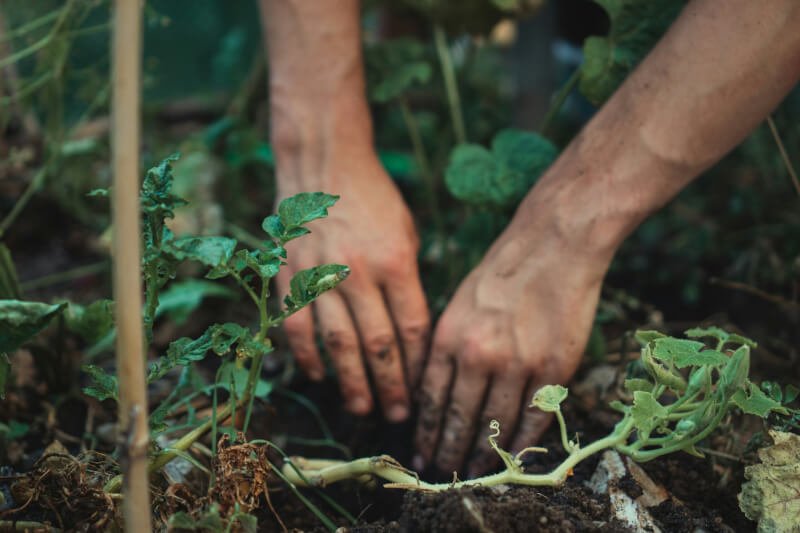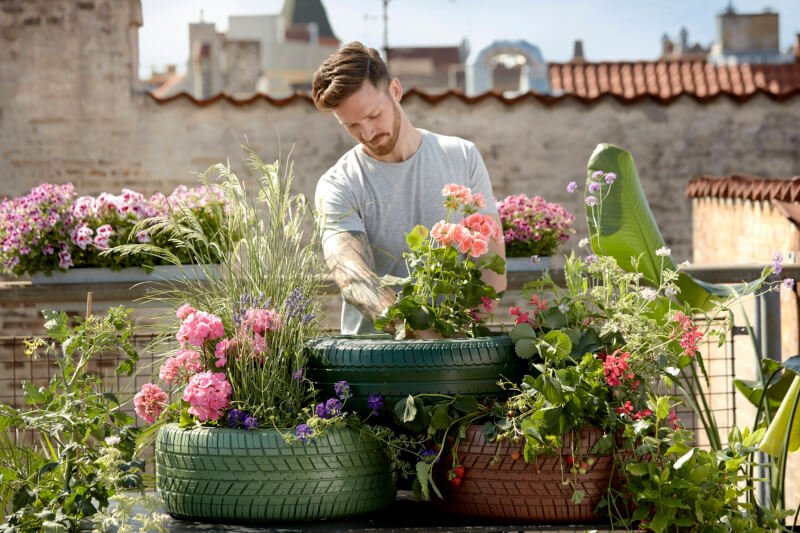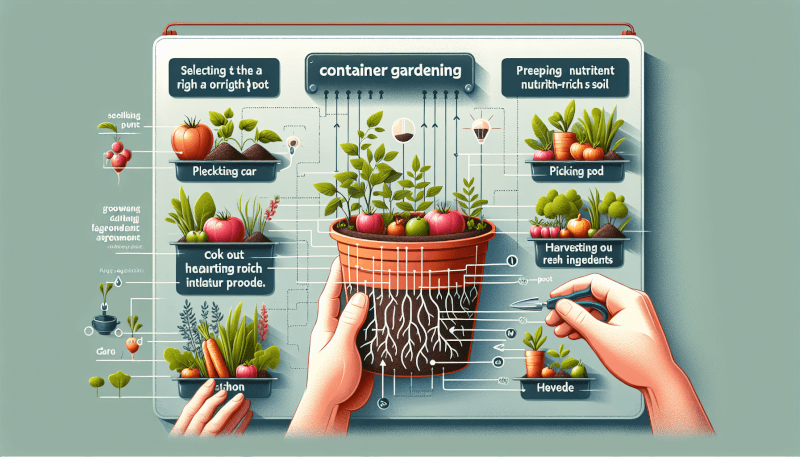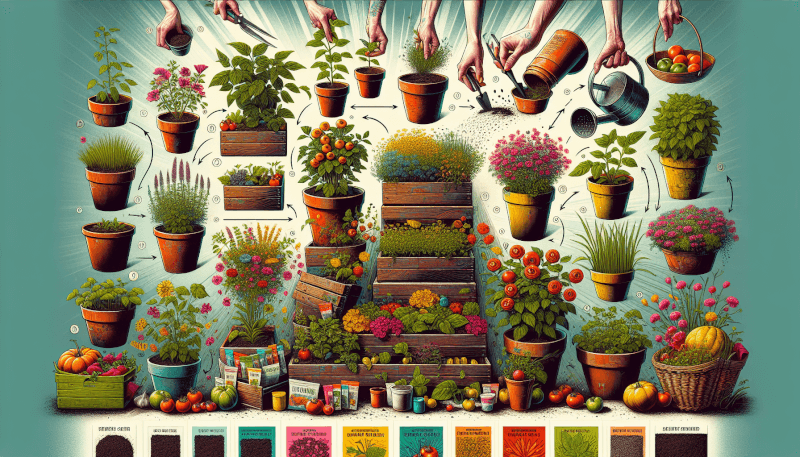Are you looking to incorporate fresh, nutritious ingredients into your cooking but lacking outdoor space for a traditional garden? Look no further than container gardening! This ultimate guide will walk you through the ins and outs of container gardening, from choosing the perfect containers to selecting the right plants for your desired recipes. Whether you have a small balcony or a sunny windowsill, container gardening offers a practical and convenient solution for growing your own herbs, vegetables, and fruits. Get ready to unleash your inner green thumb and elevate your culinary creations with the flavors of homegrown goodness.

Choosing the Right Containers
Size of Containers
When choosing containers for your container garden, size matters. The size of your plants will determine the size of the container you need. Larger plants, such as tomatoes or peppers, require larger containers that can accommodate their root system and allow for proper growth. On the other hand, smaller plants like herbs or leafy greens can thrive in smaller containers. It’s important to choose a container that provides enough room for the plants to grow and allows for proper drainage.
Material of Containers
The material of the container is another important factor to consider. There are various options available, including plastic, ceramic, clay, and wooden containers. Plastic containers are lightweight and durable, making them a popular choice for many gardeners. Ceramic and clay containers are more attractive but can be heavy and prone to cracking. Wooden containers are natural and aesthetically pleasing, but they may rot over time. Consider the specific needs of your plants, the climate you live in, and your own personal preferences when choosing the material for your containers.
Drainage Holes
Proper drainage is essential for the health and well-being of your plants. When selecting containers, make sure they have drainage holes at the bottom. These holes allow excess water to escape, preventing your plants from sitting in waterlogged soil. If your chosen container does not have drainage holes, you can drill them yourself. Without adequate drainage, your plants are susceptible to root rot and other water-related diseases.
Number of Containers Needed
The number of containers you need will depend on the amount of space you have and the variety of plants you want to grow. Consider the size of your balcony or patio and how many containers it can accommodate. Additionally, think about the types of plants you want to grow. Some plants, like herbs, can be grouped in one large container, while others may require their own individual pots. Plan out your garden layout and determine the number of containers you need accordingly.
Selecting the Ideal Location
Sunlight Requirements
Before you start planting, it’s important to understand the sunlight requirements of your chosen plants. Most plants thrive in full sun, which means they need at least 6 to 8 hours of direct sunlight daily. However, some plants, like leafy greens or herbs, can tolerate partial shade. Assess the amount of sunlight your balcony or patio receives throughout the day and choose plants that match those conditions. If you have limited sunlight, consider using shade-loving plants or investing in grow lights.
Access to Water Source
Having easy access to a water source is vital for the success of your container garden. Containers tend to dry out more quickly than traditional garden beds, so it’s important to provide regular and adequate water to your plants. Ensure that your chosen location has a nearby water source, such as a hose or faucet. If you don’t have convenient access to water, consider setting up a rain barrel or investing in a watering system to make watering your plants more efficient.
Protection from Weather
Container gardens are vulnerable to changes in weather conditions, so it’s essential to choose a location that offers some protection from extreme temperatures, strong winds, or heavy rainfall. If possible, place your containers against a wall or fence that can act as a windbreak. Consider using shade cloth or umbrellas to protect your plants from scorching summer sun. Be mindful of potential frost or hail events and have a plan for bringing your plants indoors or covering them with protective materials when necessary.
Balcony or Patio Considerations
If you’re planting a container garden on a balcony or patio, there are a few additional considerations to keep in mind. Check the weight-bearing capacity of your space to ensure it can support the weight of your containers when filled with soil and plants. Some balconies may have weight restrictions, so it’s important to know the limitations before you start. Also, consider the aesthetic appeal of your garden and how it will interact with your outdoor living space. Choose containers and plants that complement your balcony or patio décor and create an inviting atmosphere for relaxation and enjoyment.

Essential Tools and Supplies
Garden Gloves
Garden gloves are an essential tool for any gardener, especially when working with container gardens. They protect your hands from dirt, thorns, and other potential hazards while providing a better grip when handling plants and tools. Invest in a good pair of gloves that fit well and provide adequate protection for your specific gardening needs. Look for gloves that are made of durable materials and offer breathability to prevent excessive sweating.
Hand Trowel
A hand trowel is a versatile tool that every container gardener should have. It is used for planting, digging, and transplanting seedlings. Look for a trowel with a comfortable handle and a sturdy blade. Stainless steel blades are preferred as they are rust-resistant and easy to clean. Opt for a trowel that is the right size for your hand, as a comfortable grip will make your gardening tasks much more enjoyable.
Pruning Shears
Pruning shears are essential for maintaining the health and shape of your container garden. They are used for trimming and pruning plants, removing dead or damaged foliage, and shaping bushes or vines. Look for pruning shears with a clean and sharp cutting blade. Consider the size and weight of the shears, as well as the comfort of the handle, to ensure that they are easy to use for extended periods of time.
Watering Can
A watering can is a must-have tool for container gardening. Unlike traditional garden beds, containers require regular watering to keep the soil moist. Choose a watering can with a long spout that allows you to easily reach all your containers. Look for a can with a comfortable handle and a removable rose attachment that provides a gentle and even flow of water. Consider the material of the watering can, as plastic cans are lightweight and easy to maneuver, while metal cans are more durable but heavier.
Potting Soil
Choosing the right potting soil is crucial for the success of your container garden. Avoid using garden soil as it may be too heavy and prone to compaction. Instead, opt for a high-quality potting mix that is specifically formulated for container gardening. Look for a mix that is lightweight, well-draining, and rich in organic matter. Consider the specific needs of your plants, such as moisture retention or aeration, and choose a potting soil that provides the right balance.
Fertilizer
To keep your container garden healthy and productive, it’s important to provide regular fertilization. Container plants rely on the nutrients available in the potting soil, which can deplete over time. Choose a fertilizer that is tailored to the specific needs of your plants, such as a balanced or organic fertilizer. Follow the recommended application rates and schedules to avoid over or under fertilizing. Consider using slow-release fertilizers or organic options, which provide a steady and long-lasting source of nutrients.
Mulch
Mulching is an effective way to conserve moisture, suppress weeds, and regulate soil temperature in your container garden. It helps to retain moisture by preventing evaporation from the soil surface and reduces weed growth, which can compete with your plants for nutrients and water. Choose a mulch that is suitable for containers, such as wood chips, straw, or compost. Apply a layer of mulch around the base of your plants, ensuring that it does not come into direct contact with the stems or leaves.
Choosing the Right Plants
Herbs
Herbs are a popular choice for container gardening due to their compact size and versatility in the kitchen. Some commonly grown herbs in containers include basil, rosemary, thyme, and mint. Consider the growth habits and size requirements of each herb when selecting your plants. Many herbs thrive in full sun, but some, like parsley or cilantro, can tolerate partial shade. Be mindful of the specific watering and fertilizing needs of each herb to ensure their successful growth.
Leafy Greens
Leafy greens, such as lettuce, spinach, and kale, are excellent choices for container gardening. They have shallow root systems and can be easily grown in smaller containers. Leafy greens prefer partial shade to full sun, as excessive heat can cause them to bolt or become bitter. Choose varieties that are suitable for the specific season you are planting in, as some leafy greens prefer cooler temperatures. Harvest the outer leaves regularly to encourage continuous growth.
Vegetables
Many vegetables can thrive in containers, making them a great choice for home gardeners with limited space. Tomatoes, peppers, cucumbers, and beans are popular options for container gardening. Select compact or dwarf varieties that are well-suited for containers and have a good yield. Pay attention to the growth requirements of each vegetable, as some may require trellising or staking for support. Consider the time to maturity and the climate in your area when choosing vegetable varieties for your container garden.
Fruits
While some fruits may require larger containers and more care, certain varieties can be successfully grown in containers, providing you with homegrown fruit right on your balcony or patio. Strawberries, blueberries, and dwarf fruit trees are excellent fruit options for container gardening. Choose fruiting plants that are specifically bred for container cultivation and suitable for your climate. Be prepared to provide adequate water, nutrition, and proper pollination for your fruiting plants.
Edible Flowers
Edible flowers add beauty and flavor to your container garden. They can be used to garnish dishes, infuse oils, or create floral arrangements. Some edible flowers that are easy to grow in containers include nasturtiums, pansies, and marigolds. When selecting edible flowers, ensure that they are free from pesticides and herbicides. Familiarize yourself with the flavors and culinary uses of different edible flowers, as some may have a spicy or bitter taste. Incorporate these vibrant blooms into your container garden to add a touch of color and taste.

Planting Techniques
Starting from Seeds
Starting your plants from seeds is an economical and rewarding way to fill your container garden. Follow the instructions on the seed packets for the proper planting depth and spacing. Start seeds indoors in seed trays or small pots, using a seed-starting mix that provides good drainage. Keep the soil consistently moist and provide ample light for seed germination. Once the seedlings have developed several true leaves, transplant them to larger containers, taking care not to damage the delicate roots.
Transplanting Seedlings
If starting seeds from scratch seems daunting, you can opt to purchase seedlings from a local nursery or garden center. Transplanting seedlings is an easier and quicker way to get your container garden started. Choose healthy and sturdy seedlings that are free from pests and diseases. Before transplanting, harden off the seedlings by gradually acclimating them to outdoor conditions over the course of a few days. Dig a hole in your container, gently place the seedling in the hole, and carefully backfill with potting soil, firming it around the base of the plant.
Dividing and Propagating
Dividing and propagating plants is another way to expand your container garden without purchasing new plants. This method is particularly useful for perennials or plants that tend to spread and overcrowd their containers. Gently remove the plant from its container and carefully divide it into smaller sections, ensuring that each section has enough roots and foliage to survive. Plant the divided sections in separate containers, providing adequate space for growth. Water thoroughly and monitor the newly divided plants for any signs of stress or transplant shock.
Choosing the Right Depth
The depth of your container is crucial for the proper growth and development of your plants’ root systems. As a general rule of thumb, the depth of the container should be at least twice the length of the plants’ roots. Deep-rooted plants, such as tomatoes or peppers, require deeper containers that can accommodate their extensive root systems. Shallow-rooted plants, such as herbs or leafy greens, can thrive in shallower containers. Check the specific planting requirements for each plant and choose containers with the appropriate depth to ensure optimal growth.
Caring for Your Container Garden
Watering Needs
Proper and timely watering is essential for the health and vitality of your container garden. Container plants tend to dry out more quickly than plants in the ground, so it’s important to monitor the moisture levels regularly. Check the soil moisture by sticking your finger about an inch into the soil. If it feels dry, it’s time to water. Use your watering can or a hose with a gentle spray nozzle to water your plants thoroughly until water drains out through the drainage holes. Avoid overwatering, as it can lead to root rot and other moisture-related issues.
Fertilizing Schedule
Container plants rely on the nutrients available in the potting soil, which can deplete over time. Regular fertilization is necessary to replenish these nutrients and promote healthy growth. Follow the recommended fertilizing schedule for your specific plants, using either a balanced or organic fertilizer. Apply the fertilizer according to the package instructions, ensuring that you distribute it evenly throughout the container. Be mindful of the plants’ specific nutritional requirements and adjust the fertilizing schedule accordingly.
Pest and Disease Management
Container gardens are not immune to pests and diseases. Regular monitoring and proactive management are key to preventing and controlling pest and disease issues. Inspect your plants regularly for any signs of pests, such as chewed leaves, webbing, or discoloration. Remove any affected leaves or plants to prevent the spread of pests. Consider using natural pest deterrents, such as companion planting or homemade organic sprays. Keep your garden clean and free of debris to minimize disease outbreaks and provide good air circulation to prevent fungal infections.
Pruning and Harvesting
Pruning is an essential part of maintaining the health and shape of your container garden. Regularly check your plants for any dead or damaged foliage and remove them promptly. Prune back overgrown or leggy plants to encourage bushier growth. Harvest your plants when they reach the appropriate maturity for consumption. For leafy greens, harvest the outer leaves as needed, allowing the center to continue growing. Use clean and sharp pruning shears to make clean cuts and avoid damaging the plants.

Creating a Vertical Garden
Choosing the Right Trellis or Support
Vertical gardening is a great way to maximize your growing space in a container garden. Choose the right trellis or support structure based on the specific plants you want to grow. Consider the weight and growth habits of the plants, as well as the size and stability of the trellis. Ensure that the trellis or support structure is securely anchored to prevent toppling or damage to your plants.
Climbing Plants vs. Bushy Plants
When creating a vertical garden, you have the option to choose between climbing plants or bushy plants. Climbing plants, such as tomatoes or cucumbers, require a support structure and can be trained to grow vertically. Bushy plants, like herbs or leafy greens, tend to have a more compact growth habit. Select plants that are suitable for vertical gardening and have the ability to thrive in smaller containers.
Arranging Plants for Optimal Growth
The arrangement of your plants is crucial for their optimal growth and development in a vertical garden. Place taller plants towards the back or center of the garden, ensuring that they receive adequate sunlight and airflow. Place shorter plants towards the front or edges of the garden to prevent shading. Consider the specific light and water requirements of each plant and arrange them accordingly to create a harmonious and productive vertical garden.
Pest and Disease Prevention
Vertical gardens are not exempt from pest and disease issues. In fact, they may require extra vigilance due to the increased density and proximity of the plants. Regularly inspect your vertical garden for any signs of pests or diseases and take immediate action to prevent their spread. Consider using natural pest deterrents, such as companion planting or sticky traps. Provide good airflow and ventilation in your vertical garden to reduce the risk of fungal infections.
Companion Planting in Containers
Compatible Plant Pairings
Companion planting is the practice of planting certain plants together to enhance their growth and ward off pests. When selecting plants for companion planting in containers, it’s important to choose compatible pairings. Some popular companion plant pairings for containers include tomatoes with basil, peppers with marigolds, and lettuce with chives. Research the specific benefits and considerations of each plant pairing to optimize the health and productivity of your container garden.
Beneficial Insect Attraction
Companion planting not only helps deter pests but also attracts beneficial insects that prey on pests. Flowers, such as marigolds or nasturtiums, are known to attract pollinators like bees and butterflies, which are crucial for fruit production. Other beneficial insects, like ladybugs or lacewings, can help control aphids and other harmful pests. Incorporate plants that attract beneficial insects into your container garden to create a balanced and thriving ecosystem.
Natural Pest Deterrents
Companion planting can act as a natural pest deterrent in container gardens. Some plant combinations emit strong scents or produce natural compounds that repel certain pests. For example, planting garlic or onions near your leafy greens can help deter pests like aphids or caterpillars. Research the specific pest-repelling properties of different plants and incorporate them into your container garden to reduce the risk of pest infestations.
Maximizing Space
Companion planting is a great way to maximize the space in your container garden. By strategically pairing plants with different growth habits or root structures, you can optimize the use of space and achieve a more productive garden. For example, planting vining plants like cucumbers or beans next to taller plants that provide vertical support can help utilize vertical space effectively. Be mindful of the specific growth requirements and space needs of each plant to ensure they can coexist harmoniously.

Harvesting and Using Your Homegrown Produce
Harvesting Tips
Harvesting your homegrown produce at the right time is essential for flavor and nutritional value. Different plants have different harvesting requirements, so it’s important to learn the specific signs of readiness for each crop. Fruits and vegetables should be harvested when they are fully ripe but before they become overripe or start to decay. Leafy greens should be harvested when the outer leaves are mature and crisp. Use clean and sharp shears or scissors to make clean cuts and avoid damaging the plants.
Storing Fresh Produce
Proper storage is important to extend the shelf life of your fresh produce. Leafy greens can be stored in the refrigerator in a clean and dry plastic bag or container. Fruits and vegetables should be stored in a cool, dark, and well-ventilated area to prevent premature spoilage. Some produce, like tomatoes or peppers, can be stored at room temperature until they fully ripen. Be mindful of specific storage requirements for each type of produce to maintain its freshness and quality.
Healthy Recipe Ideas
One of the greatest joys of container gardening is being able to enjoy the fruits of your labor in delicious and nutritious recipes. Experiment with different combinations of herbs, leafy greens, vegetables, and fruits to create healthy and flavorful dishes. Whip up a refreshing herb-infused salad, a vibrant vegetable stir-fry, or a savory tomato and basil pasta. Let your creativity shine in the kitchen and savor the flavors of your homegrown produce.
Preserving and Canning Options
If your container garden produces a surplus of fruits or vegetables, consider preserving or canning them for future use. Preserving methods such as freezing, drying, or pickling can help extend the shelf life of your homegrown produce. Freeze extra fruits for smoothies or pies, dry herbs for seasoning, or pickle vegetables for snacks or garnishes. Research the specific preservation methods for each type of produce and follow the recommended guidelines to ensure safe and successful preservation.
Troubleshooting Common Container Garden Issues
Overwatering and Underwatering
Overwatering and underwatering are common issues in container gardening. Too much water can lead to root rot and other moisture-related problems, while too little water can cause dehydration and stunted growth. Monitor the soil moisture regularly and adjust your watering practices accordingly. Stick your finger into the soil to determine if it’s dry or moist before watering. Consider factors such as the plant’s water requirements, weather conditions, and the specific moisture needs of your container.
Nutrient Deficiencies and Excesses
Container plants rely on the nutrients available in the potting soil, which can become depleted over time. Nutrient deficiencies or excesses can lead to poor growth, yellowing leaves, or other health problems. Follow a regular fertilizing schedule and use a balanced or organic fertilizer to replenish the nutrients in the soil. Be mindful of the specific nutritional needs of your plants and adjust the fertilizing regimen accordingly. Regularly inspect your plants for any signs of nutrient deficiencies or excesses and take appropriate action.
Pest Infestations
Container gardens are not immune to pests, and infestations can quickly damage or kill your plants. Regularly inspect your plants for any signs of pests, such as chewed leaves, holes, or sticky residue. Remove any affected leaves or plants to prevent the spread of pests. Consider using natural pest deterrents, such as companion planting, insecticidal soaps, or homemade organic sprays. Monitor your plants for any pest reinfestations and take immediate action to prevent further damage.
Disease Prevention
Disease prevention is crucial for maintaining a healthy container garden. Proper sanitation, good air circulation, and regular monitoring are key to preventing disease outbreaks. Keep your garden clean and free of debris to minimize the risk of fungal infections. Provide good airflow and ventilation by spacing out your containers appropriately. Avoid overwatering, as it can create a damp environment that promotes the growth of pathogens. Monitor your plants for any signs of disease, such as wilting, discoloration, or unusual growth, and take immediate action to prevent the spread.

